Search results for: Mckinsey 7s
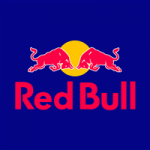
An effective utilization of marketing communication mix is one of the core sources of competitive advantage for Red Bull. According to its marketing message, ‘Red Bull gives you wings’, the company has succeeded in associating the consumption of Red Bull with an enhanced mental and physical performance and leading an active and adventurous life. Red Bull marketing communication mix integrates the following: Red Bull TV online channel addresses the interests of the target customer segment promoting the brand at the same time The Red Bulleting online magazine covers the topic of sports, culture and lifestyle indirectly promoting the brand to the target customer segment Red Bull owns a set of sports teams such as RB Leipzig,FC Red Bull Salzburg, Red Bull Brasil, New York Red Bulls, Red Bull Racing, Scuderia Toro Rosso Red Bull employs about 150 people for content marketing and media strategy[1] Advertising Print and media advertising is one of the main tools within Red Bull marketing strategy. Red Bull Media House integrates fully dedicated print, TV and digital media platforms. Along with communicating Red Bull marketing message to the target customer segment, the media house offers advertising opportunities on B2B basis, thus creating an additional source of revenues for Red Bull BmbH. Print TV Online Bergwelten The Red Bulletin Servus in Stadt & Land Terra Master Magazin Seitenblicke Servus TV ServusTV.com Red Bull Media House media platforms Beyond Red Bull Media House platforms, the company also places print and media advertisements into newspapers, magazines and TV channels popular with the target customer segment. Advertising via billboards in major cities and selected locations also plays an important role in Red Bull marketing strategy. Sales Promotion The following forms of sales promotions techniques are used by Red Bull vendors such as grocery stores, supermarket chains, bars and restaurants and retail other outlets: 1.…
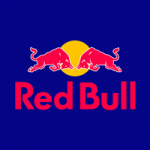
Red Bull segmentation, targeting and positioning explains which specific group of the population the company targets in order to sell their energy drinks to, by dividing the population into various segments. Segmentation involves dividing population into groups according to certain characteristics, whereas targeting implies choosing specific groups identified as a result of segmentation to sell products. Positioning refers to the selection of the marketing mix the most suitable for the target customer segment. Red Bull uses mono-segment type of positioning and accordingly, the company appeals to the wants and needs of a single customer segment. Red Bull target customer segment represent busy individuals who are overly active in their personal and professional lives and who have are fascinated by extreme sports. The following table illustrates Red Bull segmentation, targeting and positioning: Type of seg-mentation Segmentation criteria Red Bull target customer segment Red Bull Energy Drink Red Bull Sugarfree Red Bull Zero Calories Red Bull Editions: cranberry, lime, blueberry, tropical fruits Red Bull Simply Cola Geographic Region Domestic & international Domestic & international Domestic & international Domestic & international Den- sity Urban/rural Urban/rural Urban/rural Urban/rural Demographic Age 16 – 30 26 – 45 18 – 36 16 – 40 Gender Males & Females Males & Females Males & Females Males & Females Life-cycle stage Bachelor Stage young, single people not living at home Newly Married Couples young, no children Bachelor Stage young, single people not living at home Newly Married Couples young, no children Income High High High High Occu-pation Students, employees, professionals employees, professionals Students, employees, professionals Students, employees, professionals Behavioral Degree of loyalty ‘Hard core loyals’ ‘Hard core loyals’ ‘Soft core loyals’ ‘Switchers’ Bene-fits sought Enhanced performance Sense of belonging Enhanced performance Sense of belonging Enhanced performance Sense of belonging Sense of belonging Personality Ambitious Ambitious…
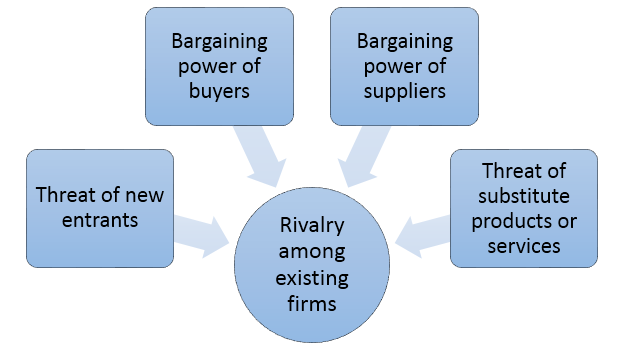
Red Bull Porter’s Five Forces identifies and analyses five separate forces that determine the overall pattern of competition in the energy drinks sector. These forces are represented in Figure 1 below: Figure 1 Red Bull Porter’s Five Forces Threat of substitute products or services is immense. Coffee is an obvious and cheaper substitute for energy drinks. Carbonated soft drinks, tea, water and juices represent additional substitute products. It is important to stress that buyer’s propensity to choose certain substitute products such as tea, water and juices may increase in the foreseeable future due to due to their increasing health-considerations fuelled by the media. There are no switching costs for customers to consume substitute products instead of energy drinks and this fact further increases the threat of substitute products. Indirect substitutions for energy drinks include getting enough sleep and leading a balanced life and this comes free of charge for the majority of customers. Rivalry among existing firms in energy drink industry is very intense. There are many energy drink brands and the rate of the growth of the industry is impressive. It has to be noted that diversity of competitors is not significant and brand equity plays a major role on the level of popularity of a specific energy drinks manufacturer. Major market players in energy drinks sector include Red Bull, Monster, NOS, Rockstar, 5-hour energy, AMP, Redline, Lucozade and others. As it is illustrated in Figure 2 below, although Red Bull is a clear market leader in energy drink segment in the US, its share in the global soft drinks and energy drinks sector is only 6.7 per cent (see Figure 3 below). Figure 2 Market share of soft drinks and energy drinks worldwide as of 2015[1] Figure 3 Energy drink market share in the US[2] Threat of new…
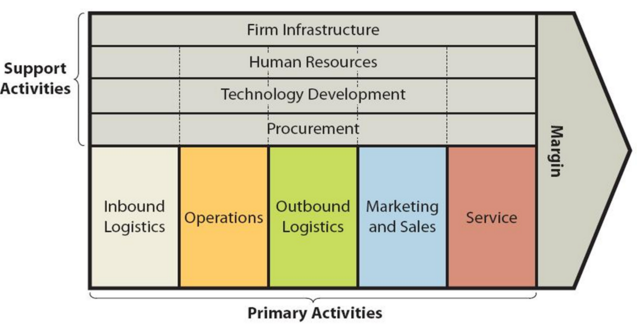
Red Bull value chain analysis is an analytical tool that can be applied to identify business activities that can create value and competitive advantage for the company. Figure below illustrates the essence of value chain analysis: Primary Activities Inbound logistics Operations With more than 5.9 billion cans sold in 2015 alone[1], the scope of Red Bull operations is extensive. The Red Bull flavouring is still produced in Bangkok and exported into manufacturing plants internationally. Wall-to-wall manufacturing technique is one of the main sources of value for Red Bull in operations primary activity. Wall-to-wall manufacturing technique involves manufacturing and filling cans on the same site and saving 8,750,000 km of truck travel annually, with highly positive implications from financial and environmental points of view.[2] Outbound logistics Red bull is sold in more than 169 countries[3] and its outbound logistics represents a complex system reflecting the size of the business. Red Bull Energy Drinks travel to their destination predominantly by train and ship. The company uses trucks only when it’s absolutely necessary. The use of train and ship is more cost-effective compared to trucks and this one of the important points in Red Bull value chain in outbound logistics. Red Bull cans are 40 per cent more space effective and 30 per cent more space effective compared to glass bottles and PET bottles containing the same quantity respectively[4]. Therefore, shape and light weight of Red Bull cans makes transportation much easier, an additional considerable source of value chain in outbound logistics operations. Marketing and sales. ‘Red Bull gives you wings’ represents an essence of Red Bull marketing communication message. This message is transmitted via a wide range of marketing communication channels on print TV and online platforms. Red Bull Media House five print magazines, one TV channel and an online TV…
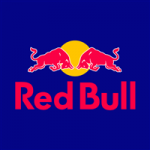
Red Bull PESTEL analysis facilitates a critical analysis of external factors affecting the energy drink manufacturer. The acronym stands for political, economic, social, technological, environmental and legal factors. Below is a brief analysis of the potential impact of each of these factors on Red Bull GmbH. Political Factors There are some political factors that affect Red Bull directly or indirectly. Specifically, a range of political factors affecting Red Bull directly include government stability or instability, levels of corruption and bureaucracy in markets, the role and freedom of press, home market lobbying initiatives and home market protectionism measures. Red Bull GmbH attempts to influence certain political factors and relevant rules and regulations via its lobbying efforts. For example, once US Food and Drug Administration (FDA) set “to investigate reports of illness, injury or death of people who took products marketed as “energy drinks” or “energy shots.”[1], “Red Bull North America has hired Podesta + Partners, the lobby firm run by power broker Heather Podesta, to “educate policymakers regarding energy beverages,” according to Senate records”.[2] Economic Factors The financial performance of Red Bull is a subject to a number of economic factors. Macroeconomic stability is one of the main economic factors affecting businesses in general and businesses operating in premium segment such as Red Bull GmbH in particular. For example, as a direct impact of the global economic crisis in 2009, Red Bull’s “net sales came in at EUR3.27bn, down 1.5% on the previous 12 months”[3]. The exchange rate between EURO and other currencies is another major factor with direct implications on Red Bull revenues. Specifically, a weak EURO throughout 2015 played a major role an increase in revenues by 15 per cent during the year, from EUR 5.110 billion to EUR 5.903 billion.[4] Moreover, additional economic factors that can affect Red Bull…
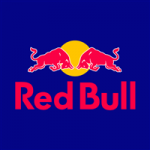
Red Bull SWOT analysis facilitates a critical assessment of strengths, weaknesses, opportunities and threats related to the energy drink manufacturer. The following table illustrates Red Bull SWOT analysis: Strengths 1. Market leadership in the global scale 2. Increasing popularity in emerging markets 3. Strong and visionary leadership by Dietrich Mateschitz 4. Solid financial position Weaknesses 1. Red Bull products considered to be unhealthy 2. Limited range of products 3. Expensive price 4. Concentrated production facilities Opportunities 1. Enhancing nutritional aspects of beverages 2. Further increasing presence in media via strategic collaborations 3. Engaging in product diversification 4. Increasing focus on CSR Threats 1. Negative health implications due to the consumption of Red Bull products 2. Increase in marketing costs 3. Further intensifying competition 4. Lawsuits against the company due to consumer health deterioration Table 1 Red Bull SWOT analysis Strengths Red Bull is sold in more than 169 countries and about 60 billion cans of Red Bull have been consumed so far. The company sold more than 5.9 billion of cans in 2015 alone.[1] Market leadership in the global scale is an indication of a considerable strength from the viewpoint of the brand equity and consumer loyalty. Red Bull is engaged in international market expansion with a focus on emerging markets in an aggressive manner. In 2015, Red Bull sales in Turkey, South Africa and India increased by 25 per cent, 19 per cent and 18 per cent respectively.[2] The current strategy of increasing presence in developing countries is set to contribute to the long-term growth prospects of the business. Dietrich Mateschitz is a proven visionary leader who had to deal with multiple obstacles during his pursuit of making Red Bull an undisputed market leader in energy drink segment around the globe. Innovative ideas of Dietrich Mateschitz for the…
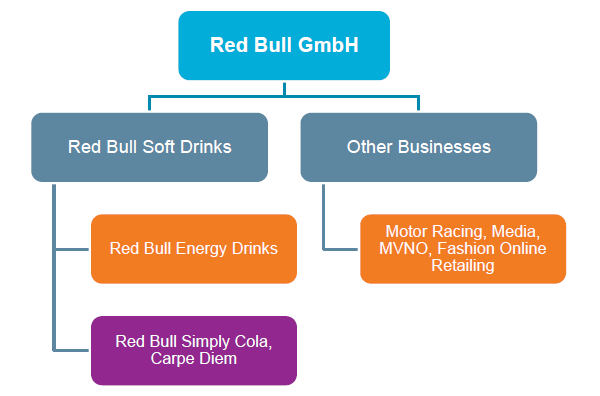
Red Bull organizational structure is divisional and the business is divided into two large businesses – Red Bull soft drinks and other businesses. It can be mentioned that divisional organizational structure “groups together those employees who are responsible for a particular product type or market service according to workflow”[1] As it is illustrated in Figure 1 below, other businesses division comprise motor racing, media, MVNO and fashion online retailing, whereas Red Bull soft drinks division is further divided into two sub-divisions: Red Bull energy drinks and Red Bull Simply Cola and Carpe Diem. Figure 1 Red Bull organizational structure The choice of divisional organizational structure by Red Bull provides the business with a set of advantages that include achieving a great focus upon a single product or service. Additionally, divisional structure allows building “a common culture and esprit de corps that contributes both to higher morale and a better knowledge of the division’s portfolio”[2]. Red Bull founder and CEO Dietrich Mateschitz subjects Red Bull organizational structure to certain changes in a systematic manner in order to reflect changes in the external environment. It is important to clarify that Red Bull organizational structure is not a typical divisional structure in a way that it also integrates certain elements of hierarchical structure in specific programs. For example, as it is illustrated in Figure 2 below, Red Bull wings program that involves distribution of free samples of products contains 6 layers of management from the team member to the program leader. Figure 2 Red Bull Wings program structure Red Bull GmbH Report comprises a comprehensive analysis of Red Bull. The report illustrates the application of the major analytical strategic frameworks in business studies such as SWOT, PESTEL, Porter’s Five Forces, Value Chain analysis and McKinsey 7S Model on Red Bull. Moreover, the report contains analyses of Red Bull’s marketing strategy and discusses…
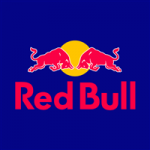
Red Bull leadership team is headed by Dietrich Mateschitz, its co-founder and long-time CEO, since its establishment in 1987. Visionary and effective leadership style of Dietrich Mateschitz is one of the major factors that fuelled the rapid growth of the business to the point of its current leadership position in the global scale. Dietrich Mateschitz had to challenge the status quo and sceptical views towards the business multiple times during his tenure as Red Bull leader. It has been noted that Dietrich Mateschitz “eschews bureaucracy and famously rejected the recommendations of a market research report which advised to him to not even try to launch an energy drink”[1]. Similar to Richard Branson of Virgin, Dietrich Mateschitz has succeeded in personification of the business and performed the role of brand ambassador in an efficient manner. Thanks to his personal interest in extreme sports and relentless drive to succeed, Mateschitz was able to create a market for Red Bull when none existed and associated the brand with extreme sports and high performance. Currently, Red Bull leadership is faced with the challenges of addressing the claims and instances related to negative health implications of Red Bull consumption. It can be argued that the relevance of this specific channel is greater than ever before due to increasing level of consumer health-awareness. Another leadership challenge in Red Bull relates to a potential leadership succession issue. To be more specific, there is no there no evident candidate to take over 72-year-old Dietrich Mateschitz the leadership role at Red Bull and such a ambiguity may threaten the company’s post-Mateschitz growth prospects. Red Bull GmbH Report constitutes a comprehensive analysis of Red Bull business strategy. The report illustrates the application of the major analytical strategic frameworks in business studies such as SWOT, PESTEL, Porter’s Five Forces, Value Chain…
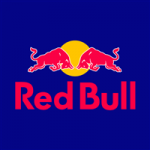
Red Bull business strategy is to associate the brand with a lifestyle of an adventurous spirit. An extensive and aggressive marketing is placed at the core of Red Bull business strategy. The brand’s marketing communication message – ‘Red Bull gives you wings’, is constantly communicated to the target customer segment via multiple marketing communication channels in an integrated manner. Red Bull business strategy is product differentiation and Red Bull is a premium energy drink. Accordingly, Red Bull energy drinks are generally more expensive compared to other energy drinks such as Monster, Rockstar, Lucozade, NOS and Amp. Customers are charged additionally for augmented benefits of Red Bull consumption that include the perception of leading a full and active lifestyle and enhancing mental and physical performance. According to Red Bull business strategy, its competitive advantages rely on the following points: First mover advantage in the energy drink sector in developed countries. Red Bull founder Dietrich Mateschitz was the first to introduce energy drinks to the west by adjusting the taste of Thai drink Krating Daeng. Unique and sweet taste of the energy drink. The Red Bull flavouring is still produced in Bangkok and exported into manufacturing plants internationally. An appealing brand image associated with extreme sports. The company owns a number of sports teams such as RB Leipzig,FC Red Bull Salzburg, Red Bull Brasil and New York Red Bulls to reinforce the brand image. Effective marketing strategy. This integrates Red Bull TV online channel, The Red Bulleting online magazine and about 150 people employed for content marketing and media strategy[1] It has to be noted that Red Bull GmbH is increasingly becoming a media company with the launch and acquisitions of increasing numbers of media businesses. This strategy serves to further strengthen Red Bull brand image via communicating relevant marketing messages to the…
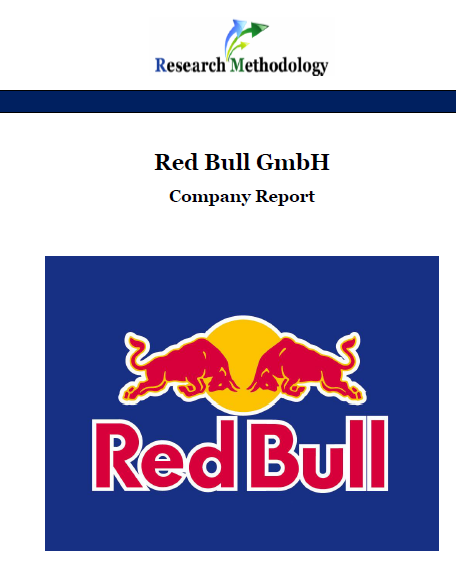
Red Bull GmbH is a manufacturer of one of the most popular energy drinks Red Bull based in Austria. The company has been founded by Dietrich Mateschitz in the mid 1980’s and the first Red Bull Energy Drink was sold in Austria on April 1, 1987. Today, Red Bull beverages are sold in more than 169 countries and about 60 billion cans of Red Bull have been consumed so far. In 2015 alone, more than 5.9 billion cans were sold, which is an increase of 6.1 per cent compared to the previous year. In 2015, Red Bull GmbH revenues amounted to EUR 5.903 billion, a 15.5 per cent increase compared to the previous year. The company employs 10,997 people in 169 countries. Red Bull pursues product differentiation business strategy and the company differentiates its energy drinks according to its perceived positive effects in terms of enhancing physical and mental performance. Red Bull brand possesses solid competitive advantages in terms of the first mover advantage, high scope of brand recognition, an impressive level of profitability and effective marketing strategy. The marketing message of the brand ‘Red Bull gives you wings’ is effectively communicated to the target customer segment via multiple communication channels in an integrated manner. Along with its own media platforms, Red Bull owns a set of sports teams such as RB Leipzig, FC Red Bull Salzburg, Red Bull Brasil, New York Red Bulls, Red Bull Racing and Scuderia Toro Rosso. Despite the phenomenal success of the company, Red Bull has a set of weaknesses that include its overly expensive prices, limited range of products, portfolio of products that are rightly considered as unhealthy and concentrated production facilities. Red Bull GmbH Report contains the application of the major analytical strategic frameworks in business studies such as SWOT, PESTEL, Porter’s Five…
